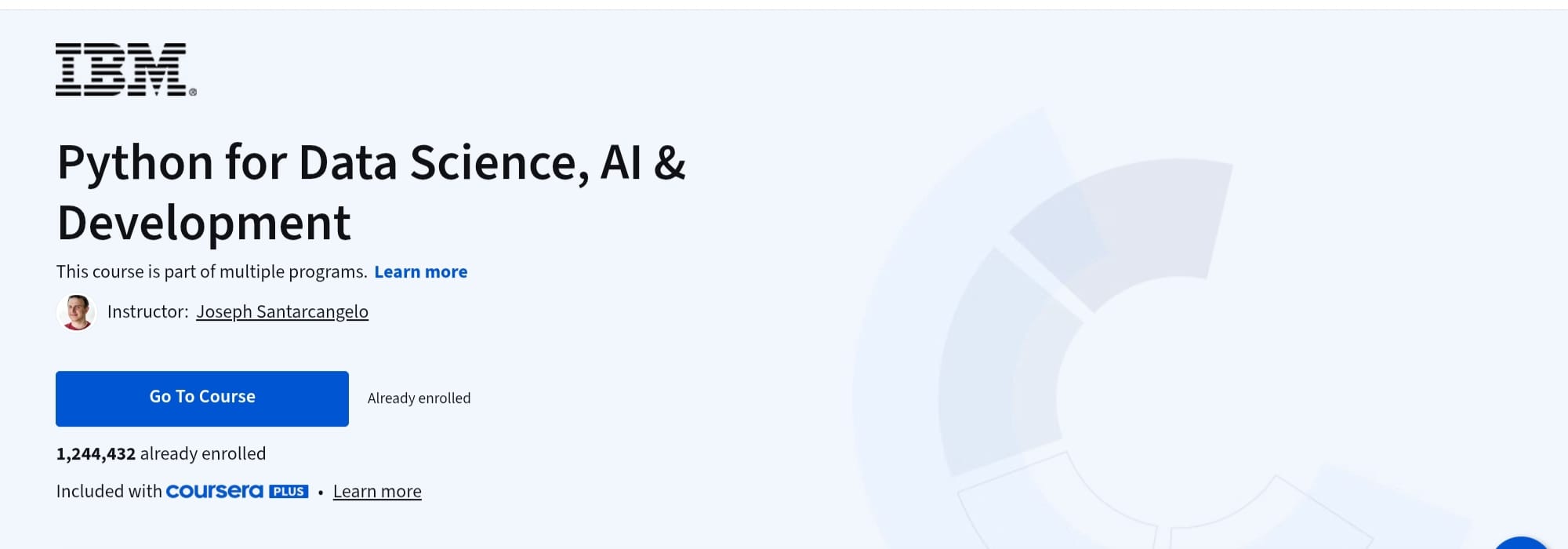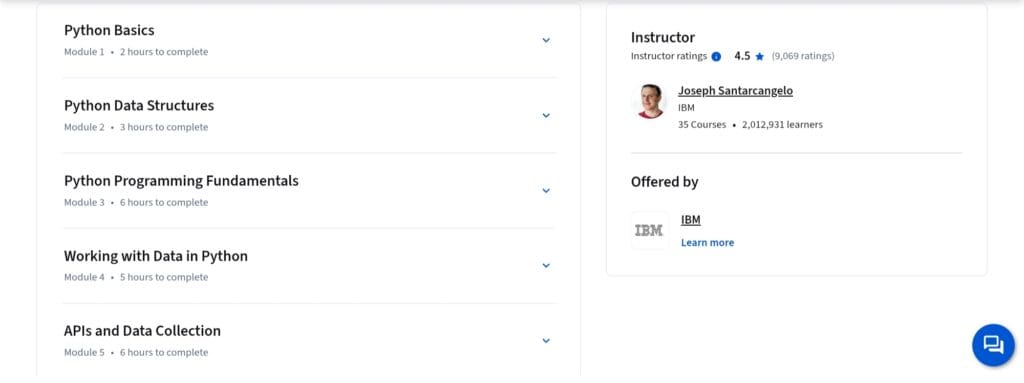If you’re just getting started in data science, artificial intelligence (AI), or software development, Python is essential. But with so many courses available, how do you choose one that genuinely delivers?
IBM’s Python for Data Science AI and Development course on Coursera is one of the world’s most popular beginner-friendly courses, with over 2.3 million enrollments. It is part of several professional certificates and specialty programs, including the IBM Data Science and AI Foundations series.
But the fundamental question remains: Is this course worth your time and money?
In this article, we’ll go over what the course includes, who it’s for, how long it takes, and whether it can help you get a job. Let’s dive in!
What Will You Learn in This Course?
IBM’s Python for Data Science AI and Development course is aimed at absolute novices. You don’t need any prior coding experience—just curiosity and a desire to learn.
Throughout the course, you’ll obtain a thorough understanding of Python programming, with a strong emphasis on real-world applications in data science and AI. Here’s an in-depth look at what you’ll learn.
Python Programming Fundamentals
You will begin by learning how Python works from the ground up. This includes –
- Writing your first lines of code in Python
- Understanding syntactic rules and conventions
- Performing computations and manipulating data by using variables, data types (integers, strings, floats, booleans), and operators.
- Working with comments, indentation, and code layout to create clean, legible programs.
This part establishes the fundamental programming logic that you will utilize in all subsequent Python projects.
Data Analysis Using Pandas and NumPy
After mastering the fundamentals, you’ll use two of Python’s most potent packages to delve into the realm of data manipulation.
- NumPy: Gain proficiency in handling numerical data effectively, working with arrays, and performing mathematical operations.
- Pandas: Learn how to import CSV files, filter datasets, interact with DataFrames, and perform simple statistical calculations.
Gaining practical experience in evaluating real-world datasets will provide you with skills that are directly relevant to jobs in analytics and data science.
Data Visualization with Matplotlib
Clear interpretation and presentation are essential for data to be helpful. In this course, you learn how to:
- Make simple plots and charts with Matplotlib.
- Personalize visual components such as legends, colors, titles, and labels.
- To identify trends, patterns, and outliers in datasets, use graphs.
Gaining proficiency in data visualization will improve your ability to convey findings in research or corporate settings.
The Role of Python in AI and Machine Learning
Although it doesn’t delve deeply into AI algorithms, the course presents –
- Python’s application in data workflows, AI pipelines, and machine learning
- Examples of Python being used in the real world for AI activities like data preprocessing and model training
- The relationship between TensorFlow, Scikit-learn, and Keras—tools that are covered in later courses—and Python
This session helps you comprehend Python’s crucial position in contemporary tech stacks, laying the groundwork for further study in AI and ML.
Interactive Coding with Jupyter Notebooks
You’ll utilize Jupyter Notebooks, a data science and artificial intelligence industry standard tool. You can do the following with this tool.
- Interactively run and test code
- In a single document, combine text, code, and visuals.
- Keeping thorough records of your work is a beneficial practice for presentations and teamwork.
In the field of data science, Jupyter is an essential tool, and this course helps you become familiar with it right away.
Core Programming Concepts
The course concludes by introducing fundamental programming ideas like:
- Writing reusable code blocks is one of the functions.
- Loops: Automating monotonous jobs
- Using if/else sentences to make decisions is known as conditional logic.
- Data structures: Effective data storage through the use of lists, dictionaries, and tuples
Whether you’re training a neural network or automating a process, these ideas form the foundation of any significant Python work.
What Concepts Are Taught in This Course?
IBM’s Python for Data Science AI and Development course on Coursera is designed to teach complete beginners how to apply Python in practical data science and AI processes, in addition to teaching them how to create Python code. Here is a more thorough examination of the main ideas discussed in the course.
Python Basics
To assist you in becoming familiar with the language, the course begins with basic Python skills.
You will learn about data types such as integers, floats, strings, and booleans, how to conduct computations using operators and expressions, utilizing variables for information storage and manipulation, and carrying out string manipulations like formatting, concatenation, and slicing.
These fundamentals are crucial because they serve as the foundation for later, more complex programming.
Control Flow
Control flow statements help you write logic into your code. In this section, you’ll learn:
- How to use conditional statements (if, elif, else) to make decisions
- Writing loops (for and while) to repeat tasks efficiently
- Applying logical operators (and, or, not) to create complex conditions
These concepts are what make your programs dynamic and responsive, and they’re a critical part of problem-solving in Python.
Data Structures in Python
Efficient data handling is a must for any developer or data scientist. The course covers:
- Lists: Ordered collections that allow indexing and iteration
- Tuples: Immutable sequences for storing fixed data
- Dictionaries: Key-value pairs used for structured data
- How to manipulate these structures using built-in methods and indexing
Mastering these structures helps you manage and process data in practical ways.
Python Libraries for Data Science
Python’s extensive library ecosystem is one of its greatest advantages. You will learn about the fundamental ones in data science in this course:
Pandas: For handling tabular data (such as CSV files or spreadsheets). You will discover how to use DataFrames and Series to clean, filter, and analyze datasets.
NumPy: For managing arrays and performing numerical computations. For large-scale computations, it is quicker and more effective than Python lists.
Matplotlib: A robust visualization toolkit for making histograms, bar graphs, and line charts, among other things. To show your data graphically, you’ll learn how to make easy-to-read plots.
Any data scientist’s toolset must include these libraries.
Working with Data
Additionally, you will discover useful methods for importing, exporting, and evaluating data:
- How to read and write data, particularly in text and CSV formats
- Methods for examining, condensing, and screening datasets
- Finding unique values, sorting data, and computing means are examples of basic data analysis activities.
You can better grasp how data moves from raw files to meaningful insights with this practical experience.
Jupyter Notebooks
The course is delivered through Jupyter Notebooks, a popular interactive coding environment used in the industry. You’ll learn:
- How to write and run code cells
- How to mix code with text, charts, and annotations
- Why notebooks are ideal for experimentation, visualization, and reproducibility
This makes the course feel more like a lab than a lecture—you code while you learn.
Basic AI Concepts
Although it doesn’t go into great detail on machine learning algorithms, this course provides a high-level overview of AI workflows, such as:
- How data is gathered, prepped, and processed using Python before being fed into AI models.
- Examples of how Python works with programs like Scikit-learn, TensorFlow, or Keras (discussed in later IBM courses).
If you’re interested in the topic, you’ll leave with a comprehensive understanding of how Python drives AI and what to do next.
Who Should Join This Course?
This course is best suited for:
- Complete novices in data science or programming
- Graduates or students without a background in computer science
- Future developers, engineers, or data scientists
- Professionals pursuing careers in technology or analytics
- Anyone interested in learning Python for automation, research, or business
No prior programming or Python knowledge is necessary. This is a good place to start if you’re interested in data and want to learn Python.
Will You Get a Job After Completing the Python for Data Science AI and Development Course?
Completing this course alone won’t guarantee you a job, but it opens the door to many possibilities.
It’s a stepping stone into data science and analytics roles, machine learning and AI career paths, and technical certifications and advanced specializations.
What it does give you is a credible certificate from IBM (hosted on Coursera), solid foundational skills in Python, hands-on experience with real data, and the ability to move on to more advanced courses or certifications (e.g., IBM Data Science Professional Certificate).
How Long Does This Course Take to Complete?
As per Coursera, it takes approximately 25 hours to complete this course. However, you can go faster or slower depending on your schedule. The course is 100% online and self-paced, so you have complete flexibility.
How Much Does This Course Cost?
The course is free to audit (you can access all content without a certificate). Otherwise, you can get this course through a Coursera Plus Subscription, which will cost around ₹4,300/month in India (USD $49/month).
Also, you can access this course individually by subscribing to it for one month, three months, or six months, depending on your needs.
Is It Worth Taking the Python for Data Science AI and Development Course on Coursera?
Absolutely, particularly if you’re just starting out.
The following explains why:
- Taught by IBM: A world-renowned pioneer in AI and enterprise technologies
- Easy to Learn: No prior programming experience is necessary.
- Practical Learning: Jupyter Notebooks and actual coding exercises
- IBM Certificate: Enhances your LinkedIn profile or resume
- Gateway Course: Flows seamlessly into more complex data science and AI courses
FAQ
Is this course beginner-friendly?
Yes! It is perfect for total novices because it begins with the very foundations of Python.
Do I need to pay to access the course?
No. The course is free to audit. If you want the certificate, you must pay.
Will I get a job after this course?
Not immediately, but it positions you for further education and professional development.
Is the IBM certificate valuable?
Yes. Many recruiters and websites like LinkedIn accept the certificate, and IBM is a reputable IT brand.
How is this course different from other Python courses?
With practical examples and industry-standard technologies, it focuses especially on Python for data analysis and artificial intelligence.
Share Now
Related Articles
Top 10 Online Data Science Courses For Beginners
Generative AI 101: What Is It and How Does It Work?
Should You Learn Python Or R For Data Science?
Discover more from coursekart.online
Subscribe to get the latest posts sent to your email.



